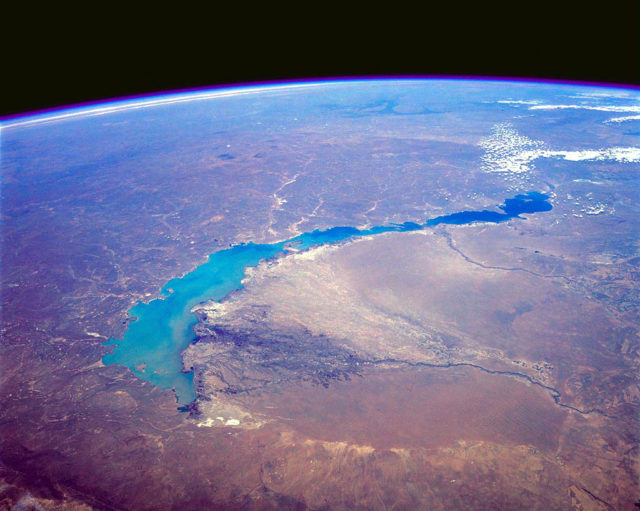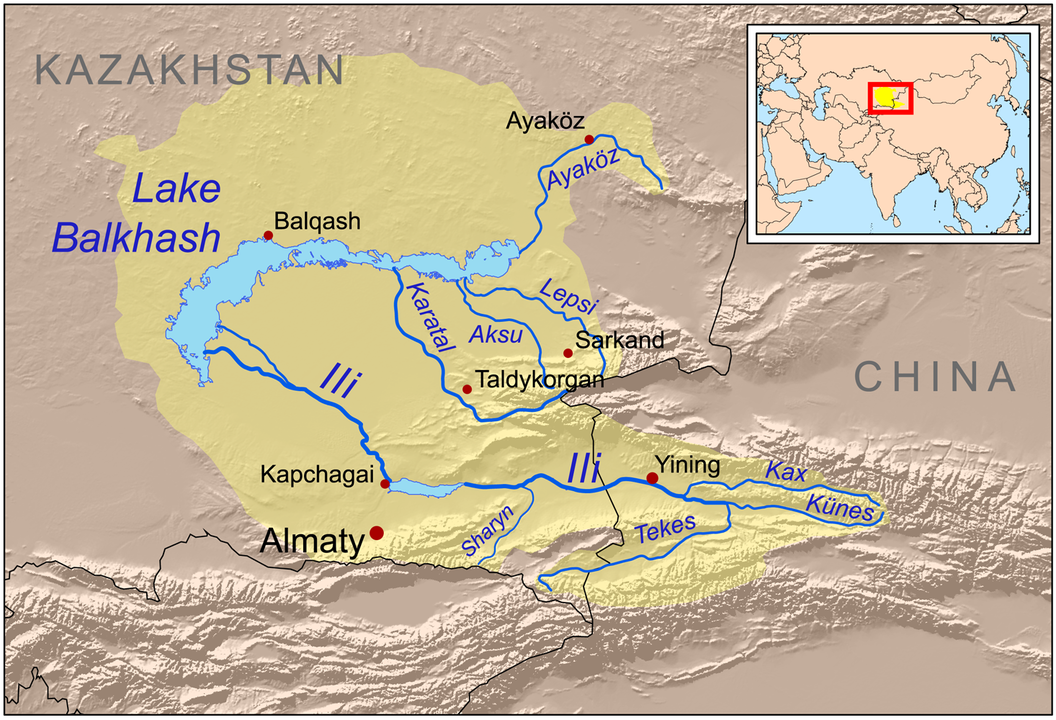
Chinese Threat to Lake Balkhash Fueling Anti-Chinese Feelings in Kazakhstan
Publication: Eurasia Daily Monitor Volume: 18 Issue: 51
By:

Kazakhstan’s Lake Balkhash, the 15th largest freshwater lake in the world, may follow the Aral Sea into extinction, Russian researcher Petr Bologov warned six years ago. Not only is the lake threatened by excessive water use by the population and agricultural development in Kazakhstan, but China had then been blocking 40 percent of the flow of the Ili River, which originates in Xinjiang and feeds the lake. Together, this contributed to a rapid decline in Balkhash’s water levels (Republic.ru, November 27, 2014). According to research conducted by scholars in the United Kingdom and Ecuador and published this past January, the Chinese are now extracting even more water from the Ili than they were, thereby putting the survival of the lake and the populations in its surrounding basin in serious doubt (Tesse de Boer et al., “Evaluating Vulnerability of Central Asian Water Resources Under Uncertain Climate and Development Conditions,” Water, February 2021). Those dire conclusions have been widely picked up in Kazakhstan and contributed to growing anti-Chinese protests there, including most recently one that occurred on March 27 (Current Times, Orda, March 27).

Lake Balkhash has been under stress since the 1970s because of Soviet-era industrial and agricultural expansion and the growth of the population around the rivers that flow into that body of water. Chinese Ila River water diversion in the northwestern corner of the country put additional pressure on the lake. Twenty years ago, the Chinese and Kazakhstani governments attempted to reach an agreement on the sharing of water. But that accord, although celebrated at the time as a solution, fell by the wayside as China decided that its domestic water needs were more important than maintaining good relations with Kazakhstan. Indeed, the situation grew far more serious after China began a (by its nature, more water-intensive) program of economically developing Xinjiang as part of its effort to attract more Han Chinese to the area and thus overwhelm the local Muslim populations. That program has also notoriously involved the incarceration of Muslims in concentration camps, an action the United States government along with human rights organizations and many people in Central Asia have vehemently condemned. In Kazakhstan, anger about such repressions has led to protests, every day for almost two months, against what is taking place inside China (Vlast, March 25).
Last weekend’s rallies in Kazakhstan were about more than just the fate of Lake Balkhash. They were the product of the government’s failure to restrict Chinese land purchases in Kazakhstan, something many there believe are part of Beijing’s plan to “expand” into the territory of their country (Orda, March 27). Fears of China’s plans for the future have been stoked by articles in the Chinese media suggesting Kazakhstan actually wants to “return” to being part of China. One such Chinese claim last year led to a diplomatic protest by Kazakhstan’s foreign ministry (Zona KZ, April 20, 2020; Kazakhstanskaya Pravda, April 14, 2020). Furthermore, Chinese industrial development, both within China and inside Kazakhstan, is contaminating the local environment, of which Lake Balkhash is a prominent part. If the lake disappears or if it becomes so polluted that its waters can no longer be used for human consumption, a third or more of Kazakhstan’s population will suffer.
The conclusions of the UK-Ecuadorian team led by environmental specialist Tesse de Boer explain why the fate of Lake Balkhash is becoming ever more a matter of concern in Kazakhstan and why Kazakhstanis are focusing on China as the culprit. The scholars acknowledge that Kazakhstani firms and populations were drawing far more water from the tributaries of the lake than would allow for its survival, but they focus their study on China’s actions in the upper reaches of the Ili River, the lake’s primary source of inflow. Beijing has restricted information about its actions in that regard, which has led Kazakhstanis and others to conclude that the situation along the Ili in China may be even worse than is currently presumed (EurasiaNet, March 17).
De Boer and her research partners point out that the Ili River valley is one of the few areas in Xinjiang with enough water to permit rapid agricultural development; and thus, it is Beijing’s best hope for attracting Han Chinese settlement to what has historically been a predominantly arid and Muslim region. But to achieve this demographic goal, the Chinese have had to take ever more water out of the Ili, reducing its downstream flow and, hence, putting the survival of Lake Balkhash at risk. What makes this situation so explosive, at least in Kazakhstan, is that the issue of the survival of the Muslim community in Xinjiang (which includes ethnic Kazakhs) and the survival of Lake Balkhash and the people around it in Kazakhstan are becoming mixed together. Anger about each interlinked factor exacerbates anger about the others.
The protests this past weekend suggest that this is becoming not only a political problem within Kazakhstan but also a problem for Nur-Sultan’s relationship with Beijing. In turn, suspicions about Chinese plans and its lack of concern for the Kazakhs and other peoples of Central Asia may constitute a serious obstacle to Beijing’s hopes for the expansion of its heavily promoted Belt and Road Initiative, of which Kazakhstan (and Central Asia more broadly) represents one key node (see EDM, March 25; see China Brief, February 4). If that should be the case, the approaching death of Lake Balkhash may have an even larger impact on the world than the fate that has already overtaken the Aral Sea.



